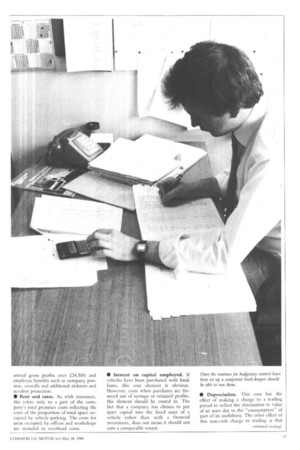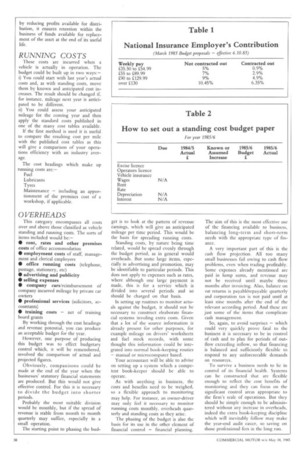PLANNING FOR
Page 38

Page 39

Page 40

If you've noticed an error in this article please click here to report it so we can fix it.
FINANCIAL HEALTH
Sound control is essential for the good health of any business, argues senior accountant Graham Forder. He explains how such control can be achieved
WHEN setting up your own business, previous experience gained as an employee in another company will be a valuable foundation. Mechanical competence, route planning ability and knowledge of the various practices and legal restrictions will be fatal.
Further, to be contemplating independence — or an expansion of for example, an existing single-vehicle operation — you would have good potential customer contacts. But in addition to these as a businessman you must have a sound understanding of financial control.
Sound financial controls are essential
for internal and external consumption. In the past it may have been possible to manage by "fire fighting", with decisions being made intuitively. However, in these times of severe competition, reduced margins, legislative restrictions on flexible use of resources and such financial constraints as the high cost of borrowing, more is required. In addition, it is largely by monetary values that third parties will measure the success of a business — be they banks, leasing companies, other providers of long-term capital or even potential suppliers. Effective financial control involves two disciplines which are distinct yet closely inter-related: budgetary control and financial planning.
These are vital to the survival of the business, and properly used aid development. They also help to avoid nasty surprises — financial problems will still arise, but at least they will have been foreseen and remedial action started.
The foundation of these disciplines is the operating budget. Controlling can be defined as the process of measuring and monitoring actual performance against pre-determined standards and taking any consequent corrective action.
For budgetary control that standard is the operating budget. As well as providing a frame of reference to monitor dayto-day operations, the budget gives a set of costs and revenues which can be manipulated to develop strategies for reaching and exceeding target profits and margins. It also gives a readily available cost structure against which new business can be priced and the profitability of business determined where the customer dictates the rate.
In developing a budget there are three areas of cost that need to be defined: 1) standing costs ii) vehicle running costs iii) overheads Together items i) and ii) can be described as total operating costs.
STANDING COS TS
These can be described as fixed operating costs and are time related: they are not influenced by the level of use of haulage capacity.
Included under this heading are: • Vehicle excise and operator licences. You would probably be aware of the precise rates for these when you are setting your annual budget. For cash flow planning keep a note in the budget papers of when the payment is due.
• Vehicle insurance. Under this cost heading include only the compulsory third-party cover and any extension or cover on the vehicle to fire and theft of fully comprehensive insurance. All other insurance payments, such as those on premises, are included in overheads.
• Drivers' employment cost. It might be thought that this item is a running cost but this is not so because they are incurred regardless of whether or not a vehicle is operating at any particular time. It is important to remember also that an employee costs more than what he receives in wages. There are in addition, the costs of the employer's National Insurance contribution (see table 1) training levies — currently 0.8 per cent of payroll for companies with
annual gross profits over .U4,500; and employee benefits such as company pension, overalls and additional sickness and accident protection.
• Rent and rates. As with insurance, this refers only to a part of the company's total premises costs reflecting the costs of the proportion of total space occupied by vehicle parking. The costs for areas occupied by offices and workshops are inciuded in overhead costs. • Interest on capital employed. If vehicles have been purchased with bank loans, this cost element is obvious. However, even when purchases are financed out of savings or retained profits, this element should be costed in. The fact that a company has chosen to put spare capital into the fixed asset of a vehicle rather than with a financial investment, does not mean it should not earn a comparable return.
Once the routines for budgetary control have been set up a competent book-keeper should be able to run them.
• Depreciation. This cost has the effect of making a charge to a trading period to reflect the diminution in value of an asset due to the "consumption" of part of its usefulness. The other effect of this non-cash charge to trading is that
by reducing profits available for distribution, it ensures retention within the business of funds available for replacement of the asset at the end of its useful life.
RUNNING COSTS
These costs are incurred when a vehicle is actually in operation. The budget could be built up in two ways:— i) You could start with last year's actual costs and, as with standing costs, move them by known and anticipated cost increases. The result should be changed if, for instance, mileage next year is anticipated to be different.
ii) You could assess your anticipated mileage for the coming year and then apply the standard costs published in one of the many cost tables available.
If the first method is used it is useful to compare the resulting cost per mile with the published cost tables as this will give a comparison of your operations efficiency with an industry average.
The cost headings which make up running costs are:—
Fuel Lubricants Tyres Maintenance — including an apportionment of the premises cost of a workshop, if applicable.
OVERHEADS
This category encompasses all costs over and above those classified as vehicle standing and running costs. The sorts of items included would be:— • rent, rates and other premises costs of office accommodation • employment costs of staff, management and clerical employees • office running costs (telephone, postage, stationery, etc) • advertising and publicity • selling expenses • company cars/reimbursement of company incurred mileage by private car owriers • professional services (solicitors, accountants) • training costs — net of training board grants By working through the cost headings and revenue potential, you can produce an acceptable budget for the year.
However, one purpose of producing this budget was to effect budgetary control which, it will be remembered, involved the comparison of actual and projected figures.
Obviously, companisons could be made at the end of the year when the businesses' statutory financial statements are produced. But this would not give effective control. For this it is necessary to divide the budget into shorter periods.
Probably the most suitable division would be monthly, but if the spread of revenue is stable from month to month quarterly may suffice, especially in a small operation.
The starting point to phasing the bud get is to look at the pattern of revenue earnings, which will give an anticipated mileage per time period. This would be the basis for spreading running costs.
Standing costs, by nature being time related, would be spread evenly through the budget period, as in general would overheads. But some large items, especially in advertising and promotion, may be identifiable to particular periods. This does not apply to expenses such as rates, where although one large payment is made, this is for a service which is divided into several periods and so should be charged on that basis.
In setting up routines to monitor actuals against the budget, it should not be necessary to construct eleaborate financial systems involing extra costs. Given that a lot of the source information is already present for other purposes, for example mileage on drivers' worksheets and fuel stock records, with some thought this information could be integrated into normal book-keeping routies — manual or microcomputer based.
Your accountant will be able to advise on setting up a system which a competent book-keeper should be able to operate.
As with anything in business, the costs and benefits need to be weighed, so a flexible approach to monitoring may help. For instance, an owner-driver may only feel it necessary to monitor running costs monthly, overheads quarterly and standing costs as they arise.
The phasing of the budget is also the basis for its use in the other element of financial control — financial planning. The aim of this is the most effective use of the financing available to business, balancing long-term and short-term needs with the appropriate type of finance.
A very important part of this is the cash flow projection. All too many small businesses fail owing to cash flow problems, even when trading profitably. Some expenses already mentioned are paid in lump sums, and revenue may not be received until maybe three months after invoicing. Also, balance on vat returns is payablerepayable quarterly and corporation tax is not paid until at least nine months after the end of the relevant according period. And these are just some of the items that complicate cash management.
So, again, to avoid surprises — which could very quickly prove fatal to the business it is necessary to be in control of cash and to plan for periods of outflow exceeding inflow, so that financing is balanced and sufficiently flexible to respond to any unforeseeable demands on resources.
To survive a business needs to be in control of its financial health. Systems can be constructed that are flexible enough to reflect the cost benefits of monitoring and they can focus on the significant control areas appropriate to the firm's scale of operations. But they should be simple enough to be administered without any increase in overheads, indeed the extra book-keeping discipline which will inevitably follow may make the year-end audit easier, so saving on those professional fees in the long run.




















































































